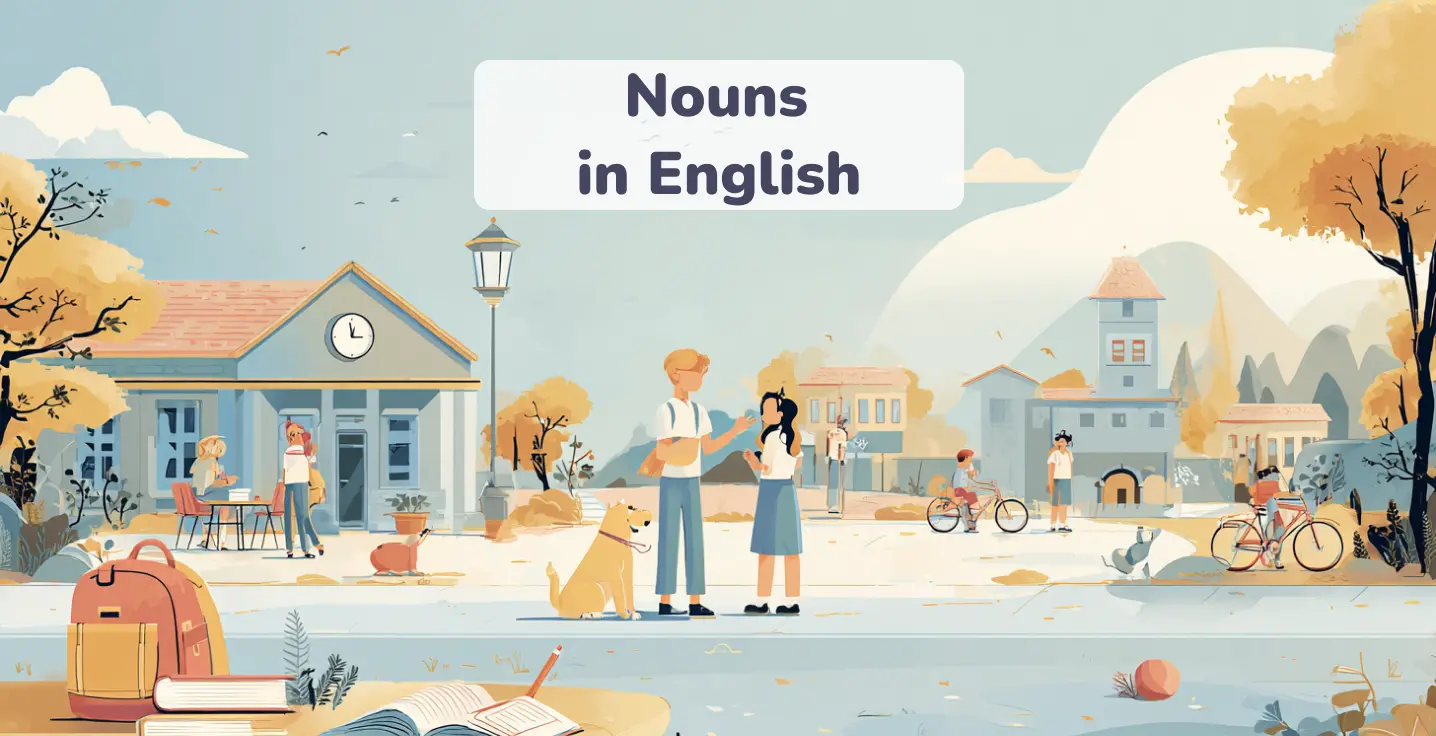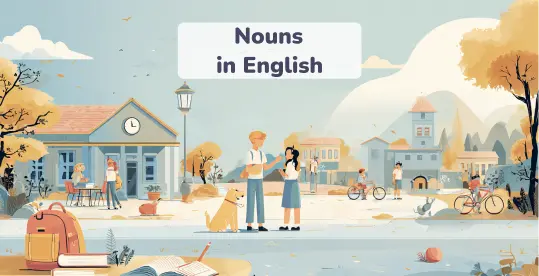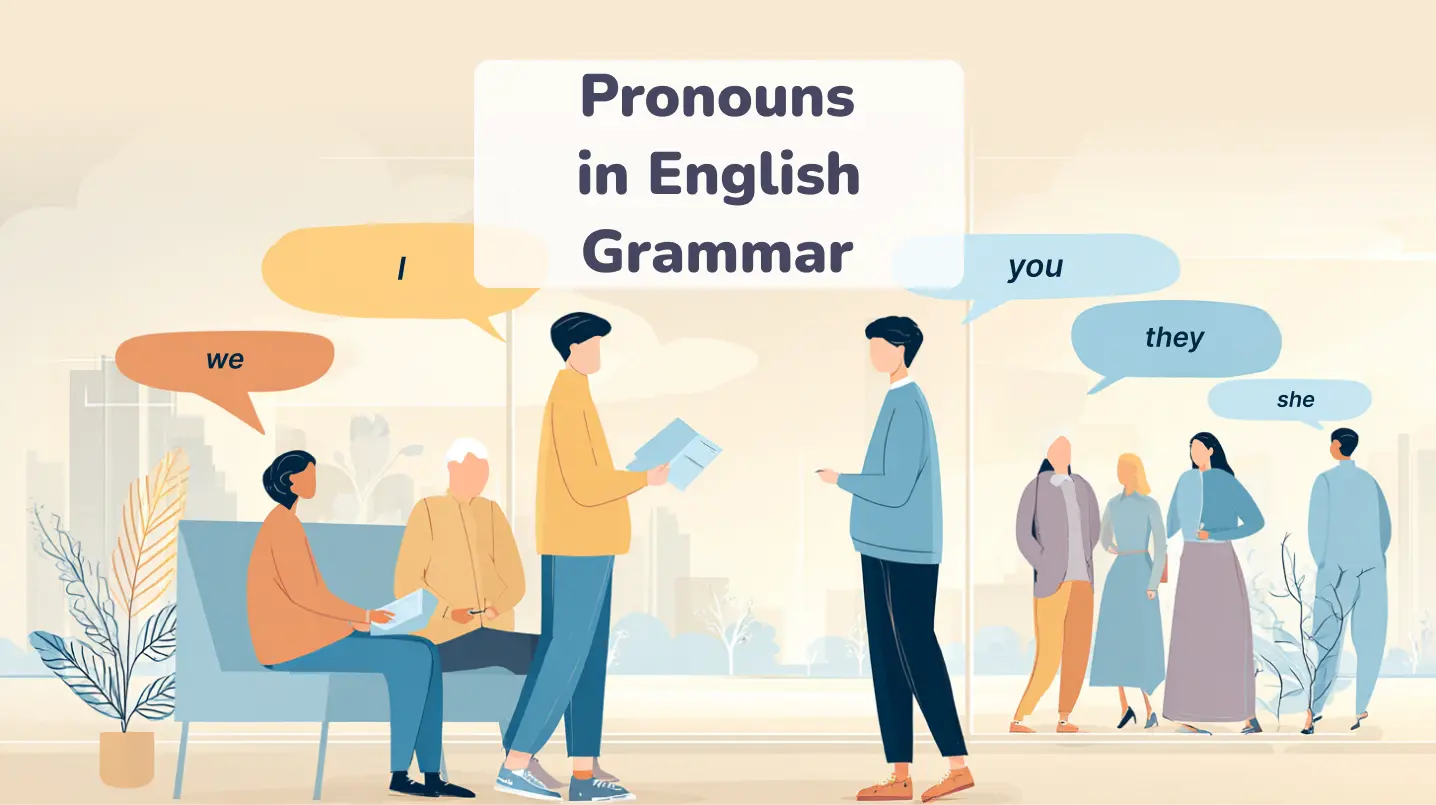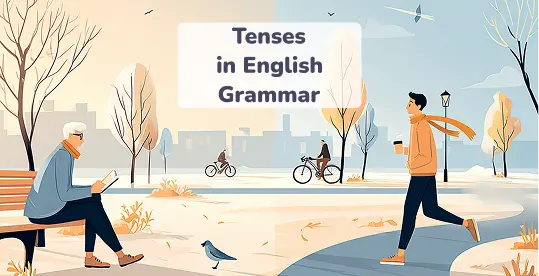What is a noun?
Nouns are words we use to give things names: people, places, objects, ideas, and feelings. Naming it, there is a noun. These words are the backbones of the majority of sentences, and they assist us in describing the world around us. They are like the labels we attach to things to have other people know our exact realization.
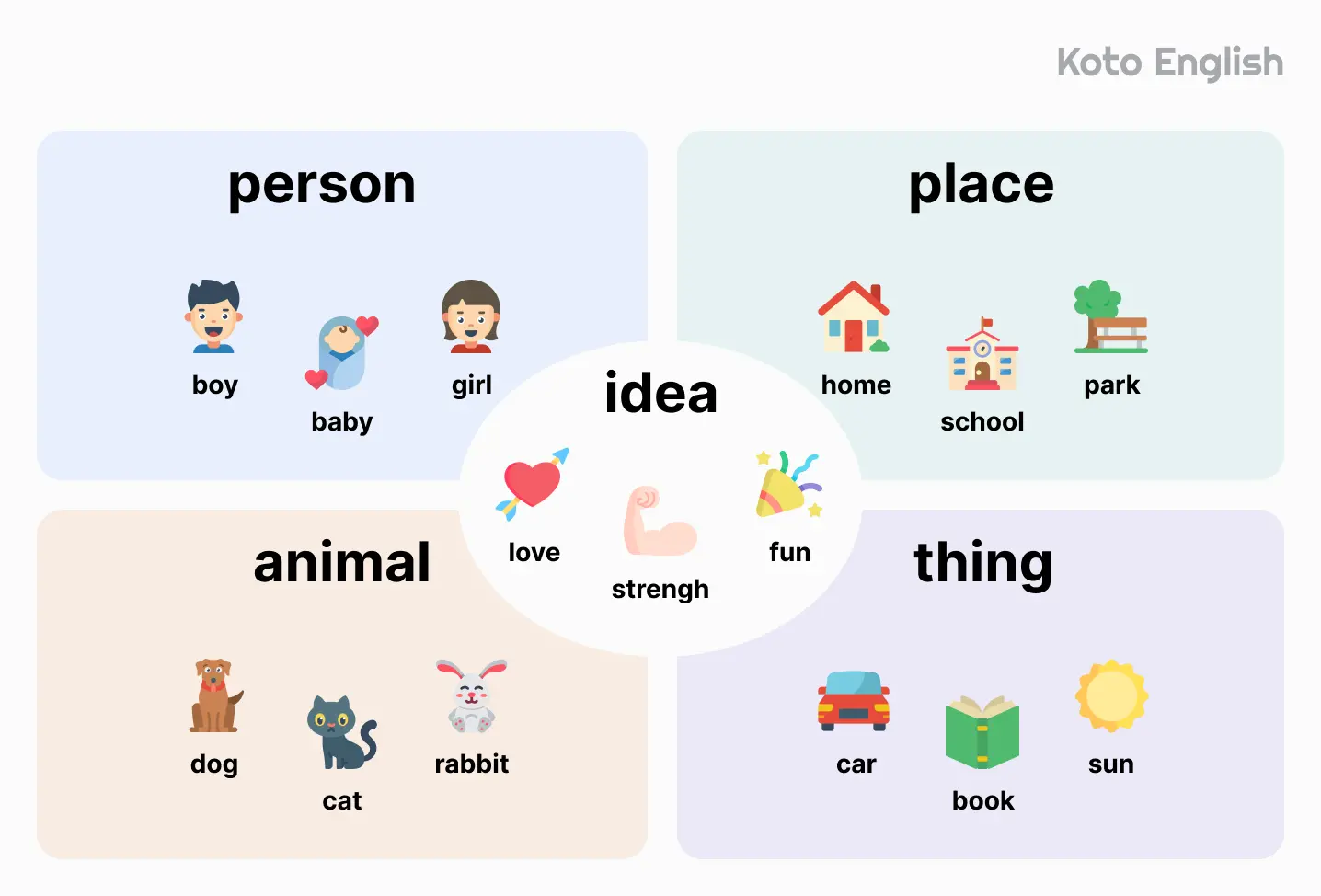

A typical noun example is this: instead of “She baked something sweet,” we can say, “She baked a cake.” The term cake refers to a noun. It tells us what she baked. This is why word nouns, just like that, clarify what you are trying to say and make your sentences live.
Here is a clunky version first:
We understand the picture technically, but it is weird and mechanical. We require nouns that are more specific. And this is what it will sound like with proper nouns:
A lot healthier, wouldn’t you say? The story has form, color, and framing now. Parts of speech noun are the magic of that because they enable us to pin down what is in our minds, to make expressions vivid and convey ideas more clearly.
Level up your English with Koto!
Types of nouns
Nouns exist in various forms and patterns, and learning about their categories assists in applying them more accurately in the speech and written word. They may be used to denote certain individuals or locations, as well as something you can count, touch or even feel. That sounds like much? No need to worry, we have simplified it.
Overview of categories
Have a glance at the following table to become accustomed to the principal types of nouns with examples that you will be able to encounter in English:
| Type | Definition | Examples |
|---|---|---|
| Common nouns | General names for things, people, or places | mountain, student, magazine |
| Proper nouns | Specific names that are capitalized | Niagara Falls, Cleopatra, YouTube |
| Countable | Things you can count (singular/plural forms exist) | chair, banana, thought |
| Uncountable | Substances or concepts that cannot be counted | sand, honesty, rice, coffee |
| Concrete | Physical things you can touch or see | backpack, elephant, laptop |
| Abstract | Ideas, emotions, or qualities | beauty, courage, sadness |
| Collective | Words for groups of people or things | jury, herd, orchestra |
| People Nouns | Words that name people by role, profession, age, or relationship | teacher, doctor, child, friend, singer, athlete |
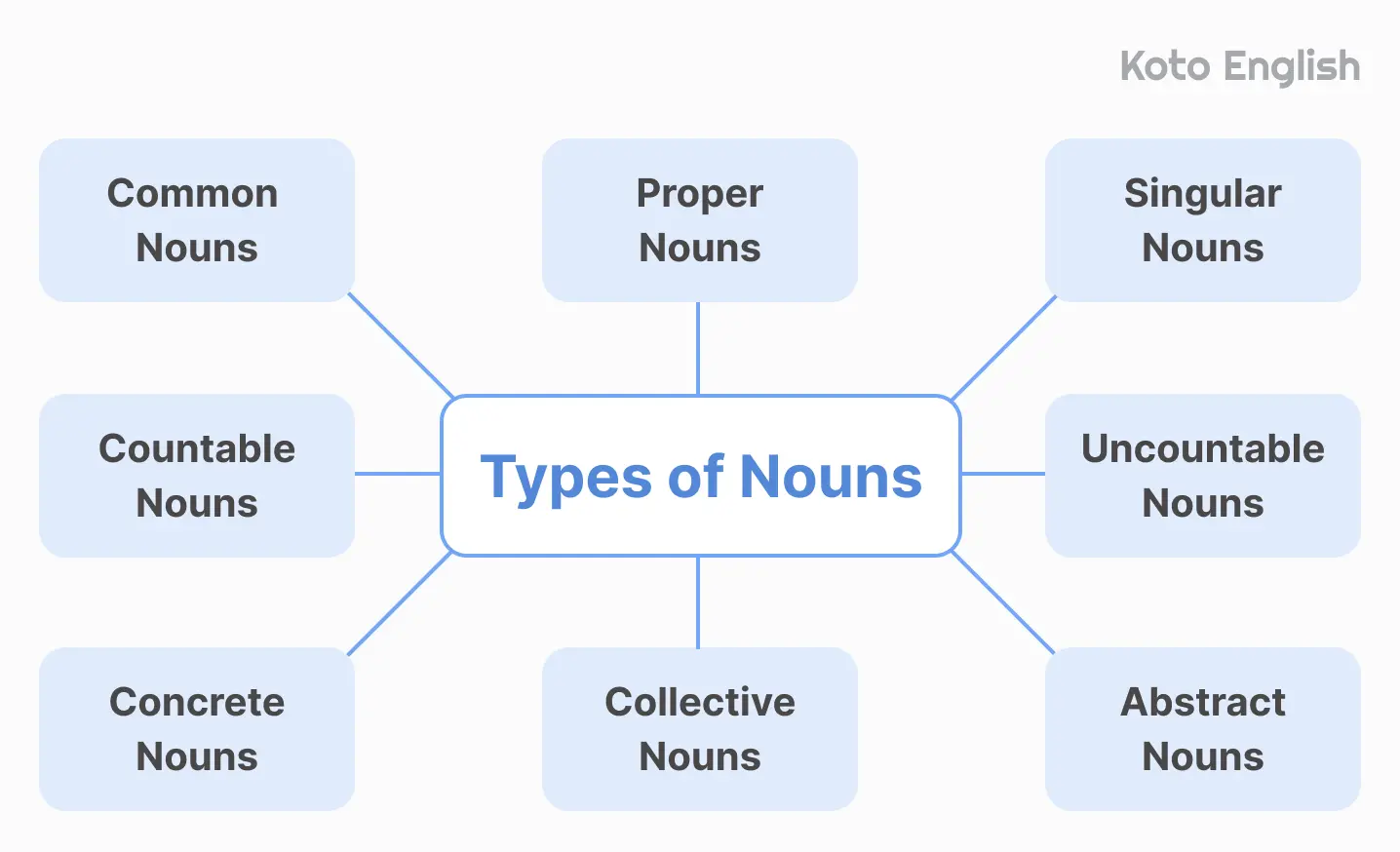
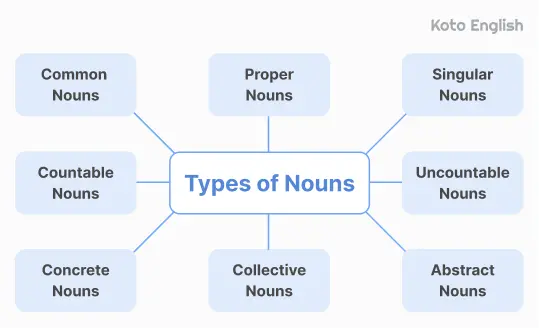
Both have their rules and their peculiarities, but when you have learned how they operate it becomes more comfortable to write well and talk with certainty. Next, we will see how to identify these nouns within sentences and also use them as a native would.
Enough theory; now, let’s illustrate that list of nouns with pictures and realistic use. These are not mere grammatical categories — they determine the way we convey our thoughts, narrate our stories and relate with others.
You will find how each of these types is used naturally in a sentence, as well as a brief explanation of how it works, so you can have some insight as to why it does what.
By meaning
— Common vs. proper nouns
Common nouns are general names of persons, places or things. They do not need capital letters except when they start a sentence.
- book
- city
- teacher
- river
- festival
Proper nouns can be understood as concrete names of individuals, locations, occurrences, or trademarks. They all start with capital letters and tell something that is distinctive.
- New York
- Leonardo da Vinci
- The Grand Canyon
- Diwali
- Spotify
Example in a sentence:
Why it matters: Lighthouse is a generic word; namely, there can be numerous lighthouses. However, Times Square is the name of a certain location, and thus it is capitalized. Personal names make your sentence accurate and characterful.
— Countable vs. uncountable nouns
Countable nouns are objects and phenomena that can be counted. They are in both plural and singlicate forms and they usually include numbers or articles:
- bottle
- teacher
- opinion
- idea
- room
Uncountable nouns denote objects that cannot be counted as separate units. The latter are called substances, feelings or categories that are viewed as wholes:
- water
- rice
- knowledge
- honesty
- weather
Example in a sentence:
Why it matters: Calls, breaks and sighs are counted by one piece but advice and information should be measured or described in a different capacity. The difference will enable you to use appropriate words such as many, some or a piece of.
— Concrete vs. abstract nouns
Concrete nouns are actual objects and can be touched physically, seen, heard, tasted or smelled.
- guitar
- snow
- perfume
- laughter
- mountain
Abstract nouns are used to mean things that are existent in the form of ideas, feelings or traits. You experience them emotionally not physically:
- joy
- freedom
- anger
- intelligence
- hope
Example in a sentence:
Why it matters: You can smell and see paint, it is concrete. However, grief is experienced internally and it impacts the thinking and behavior of people. The writings are emotionally colored using abstract nouns.
By structure
— Collective nouns
The collective nouns are used to refer to a thing or persons that are regarded as a group:
- team
- audience
- flock
- orchestra
- council
Example in a sentence:
Why it matters: Although there are numerous people indicated by these nouns, they seem to be an item and do the work of a single item in the sentence. Knowledge of collective nouns will enable you to find the right verbs to use with them and ensure that your sentence flows soundly.
Learning these categories helps you not just recognize nouns, but use them with confidence. They shape how you express ideas, describe experiences, and connect with readers.
— Simple nouns
Examine single words that do not need other words to be used together with them. They will explain things, places and concepts in the simplest manner: astronaut, bakery, volcano, bicycle.
Example in a sentence:
Why it matters: Simple nouns form the blocks of the English language building. Being able to identify them simplifies the process of creating sentences and not confusing the message you are sending.
— Compound nouns
Compound nouns also aid in the development of more vocabulary by the combination of words into other words with alternative meaning to the words. This combination can be in the form of one word, a compound form or a phrase which acts as a unit:
- mother-in-law
- rollercoaster
- swimming pool
Example in a sentence:
Compound nouns broaden the scope of expression in colloquial English. Being aware of them lets you see those cases when multiple words are used as one thought without losing the clarity and the authenticity of your writing and speech.
How to use nouns correctly in sentences?
Every sentence stands on nouns, they’re the anchors of meaning, the who, what, and where behind your words. So, what is a noun with an example? Something like car, truth, or river. Master those, and the rest of your grammar starts falling into rhythm. Here’s the cheat code for using nouns like a pro.
- Match your noun with the right article
Common nouns usually need a little helper in front — a, an, or the — to tell us if you mean one of many, one specific, or something general.
-
A or an signals something non-specific:
I sawa cat . (Any cat, no VIP treatment.) -
The points to a specific one:
I sawthe cat on your porch. (That cat you both know and maybe suspect of secret missions.)
Proper nouns skip the article spotlight because they’re already showstoppers: He works for Google.


- Keep your countable and uncountable nouns clear
Countable nouns flex their plural muscles with an -s or -es: “three books,” “many apples.”
Uncountable nouns stay singular: no “informations” or “furnitures” allowed. Instead, you say “some information” or “a piece of furniture.” Treat uncountable nouns like precious singular treasures — one size fits all.
- Use concrete nouns to ground your sentences
Want to paint a vivid picture? Use concrete nouns — things your reader can imagine, touch, or hear.
Such a sentence hits harder than “the noise rattled the windows” because thunder is concrete and punches your imagination.
- Abstract nouns bring depth and emotion
Just put a few abstract nouns there to give it a soul, emotion or idea.
Here, bravery is a punch to be felt since courage is more than a word; it is an emotion that brings people up.
- Respect collective nouns’ grammar quirks
Nouns in groups are often tricky. Occasionally, they behave as a single noun (The team is winning), occasionally plural (The team are arguing among themselves). The trick: singular verbs are to be used when you view the group as a single unit, where plural verbs are to be used when you are interested in individual members.
- Watch out for proper noun capitalization
Capital letters are the norm with proper nouns. It is like labeling a person as important when you did not do this.
The correct noun word is a matter of your audience and purpose. Want to sound formal? Use specific, exact and countable/uncountable nouns correctly. Going casual? Let the burden of nouns be lifted by concrete nouns and collective nouns.
Nouns hold your sentences in place. When they’re sharp, your noun definition is clear. When they’re weak, the message collapses.
Plural forms and possessives
The plural and possessive forms of nouns add additional meaning to your sentences. Knowing them will make you have a natural flow of writing and speaking.
Regular plurals. Plurals are most frequently made by adding an –s or –es to the noun. This easy rule applies to a large variety of words.
| Singular | Plural | Example |
|---|---|---|
| cloud | clouds |
|
| shoe | shoes |
Her
|
| leaf | leaves |
Autumn
|
Some nouns change their spelling when forming plurals. As an illustration of this, nouns that have a -f or –fe ending tend to change to -ves: leaf – leaves, knife – knives. Nouns whose endings are -y that come before a consonant transform y to i + -es: baby – babies, country – countries.
Irregular plurals. Not every noun is subject to the uncomplicated -s principle. Some alter spelling entirely, and others do not change in the singular and plural. Such anomalous plurals tend to have some historical foundations in the English language.
| Singular | Plural | Example |
|---|---|---|
| man | men |
The
|
| child | children |
The
|
| mouse | mice |
The
|
There are changes in vowels, such as foot/feet, there are added endings, such as person/people, and some remain unchanged, such as fish/fish. Yeah… this nouns list is to be learned by heart
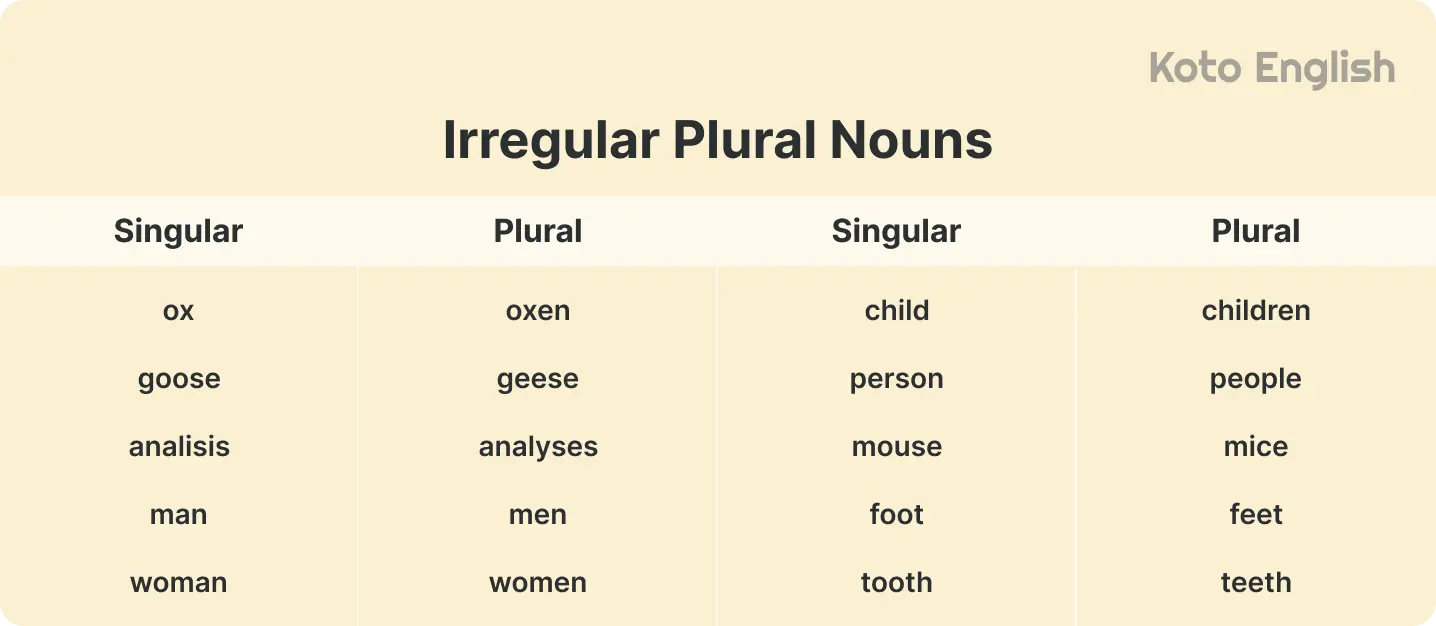
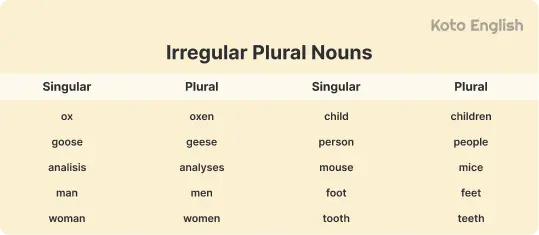
Possessive case. In English, nouns which show ownership or relationship may be expressed in the possessive form. A proper sentence structure will ensure your sentences flow well.
| Type | Form | Example |
|---|---|---|
| Singular | add ’s |
I forgot the
|
| Plural nouns ending in -s | add only an apostrophe (’) |
The
|
| Plural nouns not ending in -s | add ’s |
The
|
Singular nouns always get ’s, plural nouns ending in -s take only an apostrophe, and irregular plurals not ending in -s still get ’s.
Plural and possessive forms give your sentences precision and clarity, making your ideas easy to follow.
Grammar rules you should know
Similarly, an actor must have stage directions, nouns also have to be built upon a few key rules of grammar so that you may be able to write correct and good English. Now, here are the main facts you have to understand about the most common English nouns.
- Nouns can be subjects
Sentences need someone or something to do the action. Nouns are usually the ones doing the heavy lifting.
Robot is a noun acting as the subject of the sentence — it’s the one doing something.
- Nouns may be objects
Nouns don’t always lead the action. When they receive it instead, they’re playing the role of the object.
“Photograph” is the object receiving the action.
- Articles before countable nouns
An often stated rule: when you refer to a singular countable noun in English, you normally need an article such as a, an or the.
The word “dessert” is only one entity and is countable, thus we use the word a to begin with it.
Uncountable nouns never take a or an; use words like some or much instead, as in She shared some information.
- Not all nouns change in the plural
Remember that some nouns do not alter in any form between their singular and plural forms.
Same form, plural noun meaning.
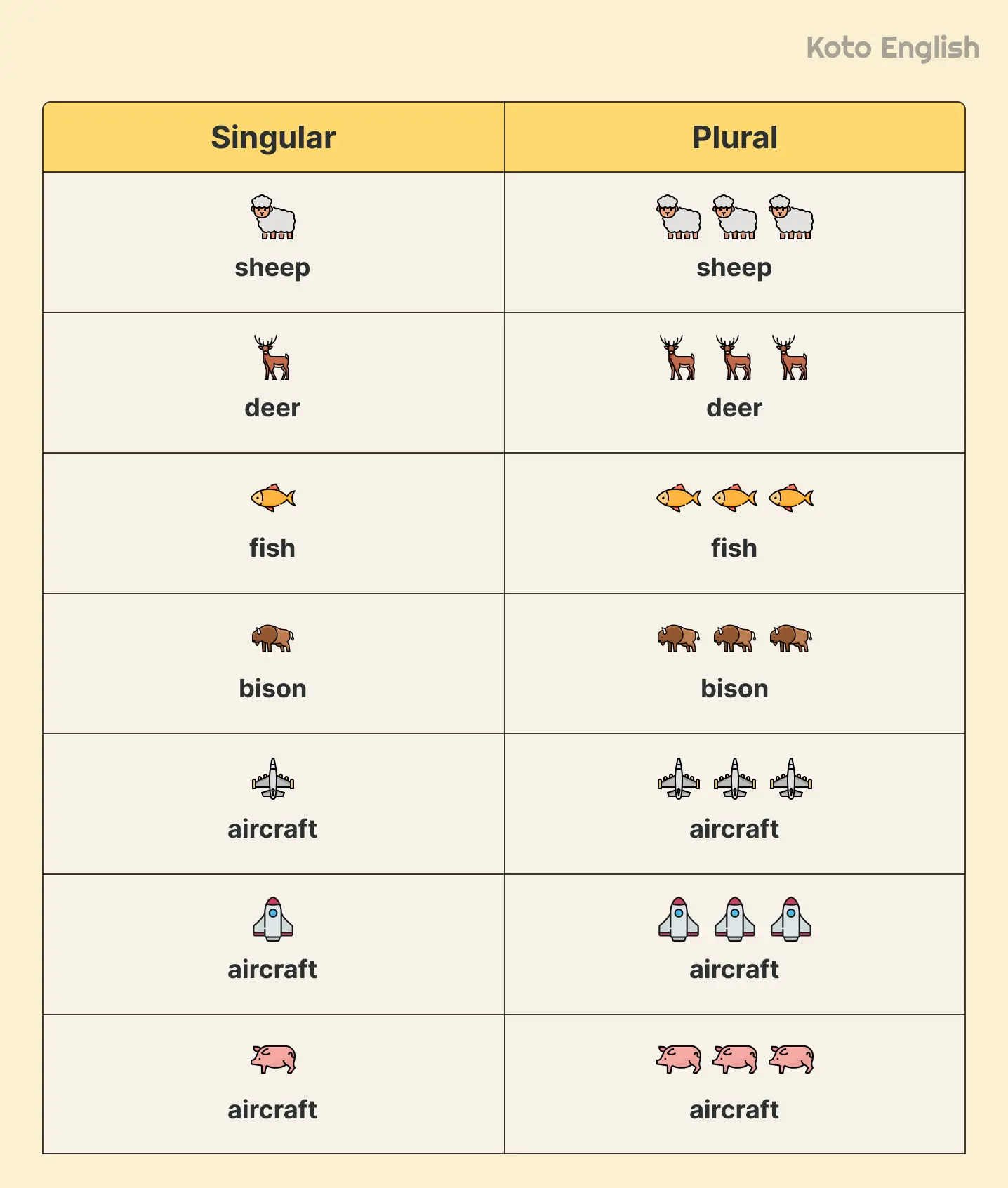
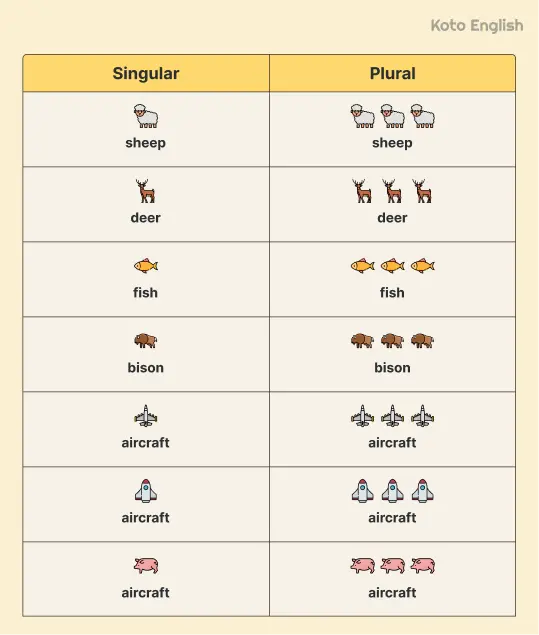
By learning those noun rules, you will have an instrument that will enable you to identify problems and prevent them in advance, and you may speak and write in a much better way. Nouns are rather simple, yet they also have guidelines, as with any other language gamers in grammar.
Common mistakes
Even with a solid grip on noun types, some areas can still trip up writers and speakers. English loves exceptions, and nouns are no different. Here are a few common pitfalls to keep your eye on.
Mistake 1. Uncountable nouns that sound countable
Words like information, advice, and furniture seem like they should work with numbers, but they don’t.
|
She gave me an advice.
|
She gave me some advice/a piece of advice.
|
|
He bought three furnitures for his apartment.
|
He bought some furniture for his apartment.
|
When in doubt, add some or use a measure word like piece, bit, or slice depending on the context.
Mistake 2. Collective nouns and verb agreement
Collective nouns are frequently singular in American English:
But in British English, it’s common to treat them as plural:
In American English, you should use a singular form of the verb when you look at a group of people as one entity. In British, a plural verb should be used when the members of the group are being highlighted as individuals.
Mistake 3. Capitalization of proper nouns
Not every capitalized word is a proper noun. And not every proper noun gets capitalized when it should.
|
Dave works at microsoft.
|
Dave works at Microsoft.
|
|
This tesla model is impressive.
|
This Tesla model is impressive.
|
Capitalize names of people, specific places, events, or organizations, but skip them unless it’s part of the official name (e.g., The Hague).
Mistake 4. Nouns that change meaning in singular vs. plural
Caution, nouns’ meaning does not necessarily remain the same in the plural. When you add that extra letter you give some of the words a new identity:
- The material is glass, but glasses generally mean eyewear.
- A work is a task or a job, but works may refer to a collection (works of a given artist).
Context is everything. Be careful of the change of these nouns’ definition in the sentence.
Mistake 5. Words that can be both countable and uncountable
Some nouns switch roles depending on how they’re used.
- Chicken (as a food) is uncountable: I had some
chicken for lunch. - Chicken (as an animal) is countable: Three
chickens escaped the coop.
Ask yourself: Am I talking about a substance or an individual item?
Enjoy personalized learning!
Practice exercises
What are nouns? You’ve seen how nouns work, spotted them in real-life sentences, and picked up the grammar behind them. Now it’s your turn to show what you’ve got with some fun, exam-style questions that’ll sharpen your skills and test your instincts.
Conversations, ideas, and notes wouldn’t be the same without nouns. What makes the definition of a noun plain and short: it is a word that describes a person, a place, a thing, or an idea. The ability to use them in the way you know your English and it feels like talking to a long-time friend.
Practical tips
Learning English nouns becomes very straightforward when you can use the tricks to recognize them along with their forms. These tips will make you learn to identify nouns fast, memorize their rules and use them effectively both in writing and speaking.
— How to spot nouns easily?
- Name people, places, or objects. Nouns are frequently used to refer to someone or something that is physically present, such as a teacher, a city, a bicycle or to something that cannot be touched, such as happiness or courage.
- Look at articles and determiners. Words such as a, an, the, my, this, can be placed before nouns.
- Ask “Who?” or “What?”. A word that answers these questions is likely to be a noun.
— Learning strategies and memory tricks.
- Write on flashcards. On one side write the noun and on the other the plural or possessive. Review them daily.
- Organize groups of nouns by category. Take lists of common, proper, countable, uncountable, concrete, and abstract nouns. It is useful to group examples of nouns to get your brain to organize information.
- Make mini-stories. Construct brief sentences or tales with the use of new nouns in order to place them in context.
- Associations with pictures or symbols. Match nouns with pictures or symbols. As an illustration, tie bakery to the smell of fresh bread and pastries filling the room.
- Real-life practice. Find nouns in authentic situations in books, articles or conversation. Attempt to determine their type, number and forms of possession.
Memory strategies used together with recognition techniques are quicker to learn. The more you write, talk, and observe nouns, the sooner they turn into second nature.
Conclusion
English nouns bring your sentences clarity and life. Types, plural forms and possessives are the keys to accurate expression of ideas and making your writing and speech more interesting. Learn English through focus on tangible and abstract nouns, straightforward and multiple forms, and typical exceptions.
Experience makes knowledge of nouns’ meaning a skill. Use spot nouns in books, in articles, in conversations, or in whatever you are writing and detect the types, plurals, and possessives. Aid memorization with tricks or flashcards or mini-stories, and it will be easy and natural to use nouns correctly sooner.
FAQ: Common questions about noun usage
One of the building blocks of the English language is nouns. They give names to people, animals, objects, places, feelings and abstract concepts, which we discuss.
There are plenty of reasons nouns are central to language, and that is why:
- They are subjects of a sentence.
- They can be the object of a preposition or a verb.
- Those assist us in defining what or whom we are speaking about.
- They put descriptions in action, operating with adjectives.
In simple terms, we would not have an idea of what is being done to whom without the nouns. It would be baking a cake without flour.
The first thing to do is to consider along which object the sentence is actually speaking. Then you have some people, places, things or objects that are being talked about; those will be your nouns. An example of a noun in the sentence:
It is possible to give some hints to help catch the nouns:
-
After articles like a, an, the
- a sandwich
- an email
- the garden
- a surprise the movie
-
With possessive words like my, your, their
- my phone
- your idea
- their house
- his jacket
- our project
-
Next to adjectives (describing words)
- a noisy classroom
- an expensive gift
- a bright star
- a cold drink
- a kind teacher
Describing nouns isn’t hard once you know what to look for. They will jump out at you like neon lights after you acquire an eye for recognizing them.
In order to use nouns confidently, you require a daily variety of exposure. The best ways are:
- Doing fill-in-the-blank or matching activities.
- Reading simple texts and highlighting the nouns.
- Writing short sentences or stories, then checking which words are nouns.
- Talking to yourself (yes, really!) to describe objects around you.
- Using tools like flashcards, grammar apps, or noun-based games.
And of course, practice brings progress along. The greater the frequency of carrying nouns in actual speech or composition, the more instinctive it becomes.
Yes, and the English is fond of this trick! These words are termed as conversion words and the role of these words depends upon their context. Noun examples are common:
- Run: I went for a run (noun) / She runs every morning (verb)
- Watch: This is a nice watch (noun) / Watch your step! (verb)
- Dance: The dance was beautiful (noun) / They dance well together (verb)
Here is a rule of thumb: see what the word does in the sentence. When it names something or an idea, then it is a noun. When it acts, it is a verb.



